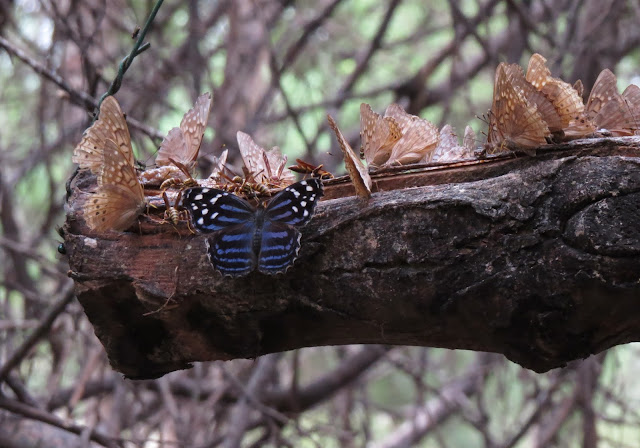All around the valley various parks and preserves have planted gardens which are expressly designed to attract butterflies. Some of these include Resaca de Palma State Park, Frontera Audubon Sanctuary, Sabal Palm Sanctuary, Estero Llano Grande State Park, Edinburgh Wetlands, the National Butterfly Center and Bentsen Rio Grande State Park. It is no secret that these gardens are quite popular (with both people and insects) and that they help to bring valuable tourist dollars into the area, supplementing the revenue from birders who visit the valley in the fall and at other times of year. Many of these sites cooperatively market themselves, giving visitors a wide range of options during their stay in the valley. I described these places in posts here and here, earlier this year.
Some of the most popular plantings in the butterfly gardens include Mistflower or Crucita (Eupatorium odoratum and related species), Lantana (Lantana urticoides), Mexican Olive (Cordia boissieri) and Turk's Cap (Malvaviscus drumondii). Here is a brilliant Blue Metalmark on Lantana:
a Cloudless Sulphur (which occurs in Ohio) on Turk's Cap:
a Southern Dogface on Mistflower (note the little poodle face on this butterfly that gives it its name!):
and American Snouts on Mexican Olive:
Even when not in bloom, the Mexican Olive attracts insects; it must exude some sort of sweet substance on the fruits. The blooms are stunning and are an excellent nectar source.
Snouts were probably the most numerous butterflies that we saw and there were literally millions of these little flyers on flowers, in the forest and in the air. People reported seeing clouds of them migrating along certain stretches of highway while we were there. Its caterpillar food plant is hackberry, and many that we saw showed lots of evidence of caterpillar use. This butterfly has a large range and is not uncommon most years in Ohio. Here is a photo of it opened up, showing its beautiful orange pattern, alongside a plant called Esperanza (Tecoma stans).
and the diminutive and well-named Red-bordered Pixie:
Another butterfly that was quite common, especially for the first few days of our visit, was the Queen, a relative of the Monarch:
Another interesting feature of many of the butterfly gardens, and particularly those that have woodland areas, is the "bait log". These are segments of small branches, hung from a tree or other support, and slathered with a mixture of beer, brown sugar, and mashed bananas. This brew attracts butterflies that aren't particularly interested in flower nectar but that utilize rotting fruit and/or sap. Most of these are Tawny Emperors:

The big guy on the left is a tarantula wasp and the large beetle on the right is a harlequin flower beetle. Assorted bees, wasps and flies usually also appear, and sometimes crowd, these bait logs.
The gorgeous Mexican Bluewing butterfly is a frequent guest at these logs and is a special feature of these semi-tropical wooded areas near the Rio Grande River:
It was absolutely stunning to see these beautiful insects flying in the dappled shade of the forests. The one in the photo above is a male; here is a female at a bait log--notice that it has more white spots on the forewings:
There were so many gorgeous butterflies that I'd like to show here but this is getting long! Here are just a few (well,maybe more than a few!) more butterfly highlights. This is another woodland butterfly called the Band-celled Sister:
The Common Mestra was indeed common in many places we visited:
Even though it was a bit tattered, this Crimson Patch was still gorgeous:
Wow--this Tailed Orange was such a beautiful pumpkin orange color:
On of the most sought-after butterflies in the valley is the Great Purple Hairstreak, which we were fortunate to see at Estero Llano Grande State Park:
Tiny but exquisite, this Red-crescent Scrub-hairstreak was an exciting find:
An open Tropical Leafwing was a real treat; most are seen closed on bait logs:
I almost forgot one of my favorites, the Ruddy Daggerwing:
Last but certainly not least is the exquisitely beautiful Silver-banded Hairstreak, nectaring on Scorpionweed. This was one of the smallest of the 90+ butterfly species that we saw:
Butterflies weren't the only attraction in the valley on our trip, and my next post will illustrate some non-lepidopteran critters!


.JPG)

















90+ different butterfly species? That's amazing. Do you know their identity when you take their pictures or do you take the pictures and then consult references? Whatever, your photography and labeling of the photos are both gorgeous and informative.
ReplyDeleteBoth! There are lots of expert butterfliers--park staff, volunteers and guides--in the valley at this time of year that are quite willing to help with identification as people are looking at the insects. But it is extremely helpful to take photographs and then look in the books later. In fact that is one thing I enjoy a lot at the end of the day--sitting down and going over our photos and checking them out in the field guides which also give some more info about each species, like their range and caterpillar food plants. I do think we learned a lot on this trip--if only we could retain it all!!
ReplyDelete